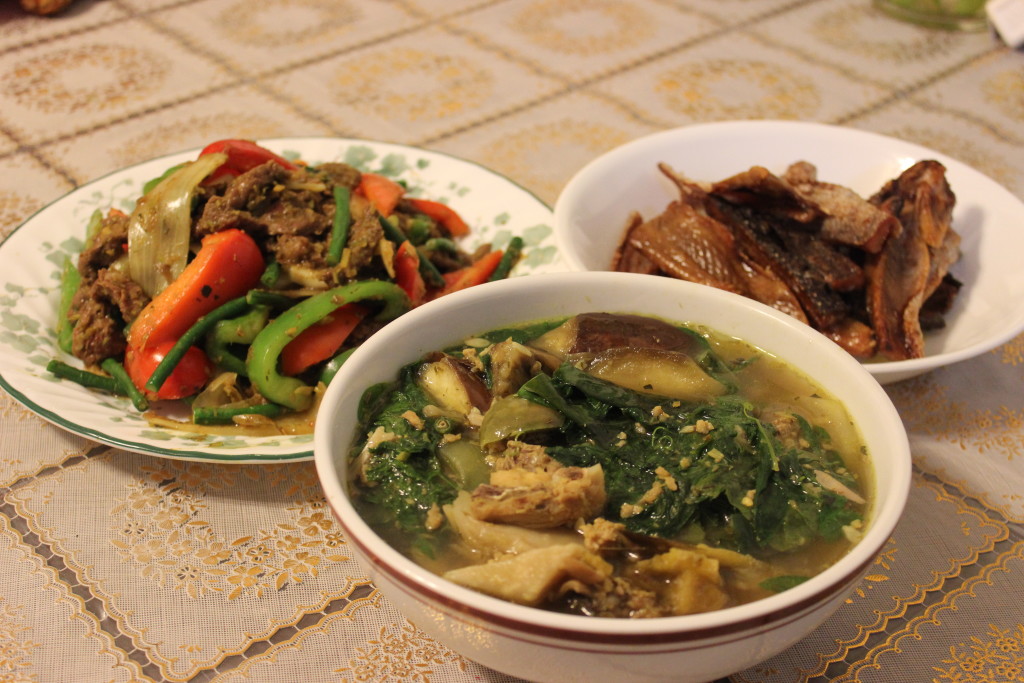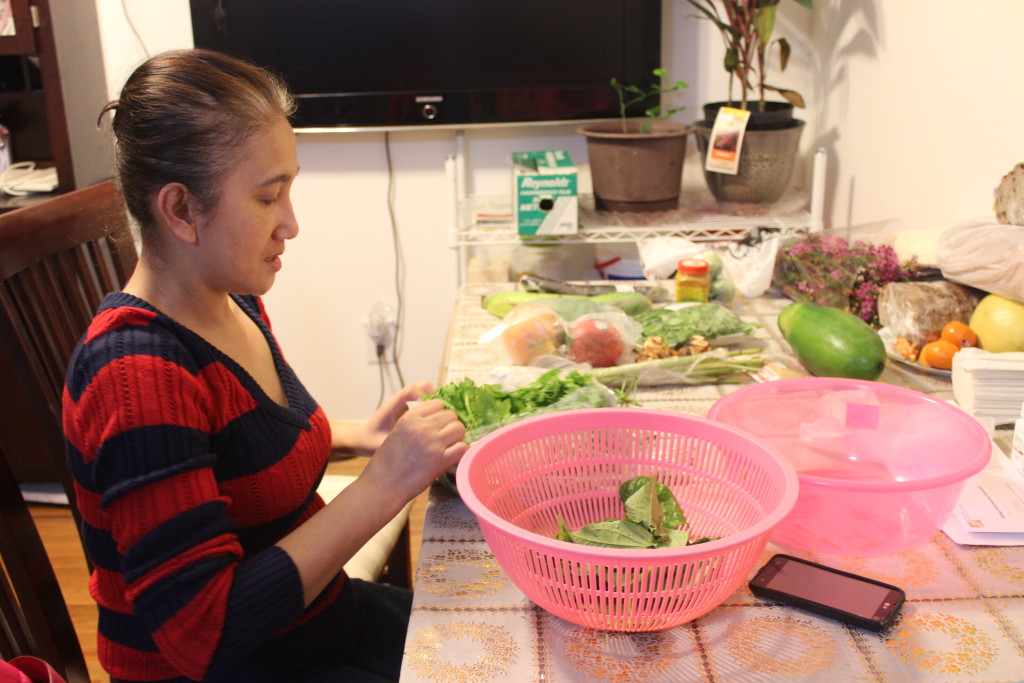It was dinnertime. In her two-story house on Harmony Avenue in the Bronx, Bolnarin San put out the green fuzzy squash, Thai eggplant, eggplant, long string beans, June leaves, onion, lemon grass, bitter lemon leaves, green jackfruit, green papaya and lime leaves that she would use to prepare dinner. The neighborhood was quiet, except for the occasional pedestrian who rushed home for warmth and food.
San’s nephew, Sokdeth Tee, had already fried chicken parts to a golden brown, and was ready to add the vegetables. “He is an excellent cook and a lucky man,” San said. Tee, 28, won a green card lottery and came to New York from Cambodia last year.
They shared Samlor Kako, a traditional Cambodian soup served with fish or chicken, and Lap Khmer, which is lime-marinated Khmer beef salad, along with fish pickles and rice.

Three Cambodian dishes: Samlor Kako, Lap Khmer, and fish pickles. Photo: Xinyu Jing.
San, now 53, came to the Bronx with her family in 1981, after a two-year wait for travel documents to the United States. She went to Bronx Community College to study accounting and since 2001 has owned a Jerome Avenue grocery store, although she cleans rooms at a Midtown Manhattan hotel to bring in extra income. Her husband of 11 years is a Thai cuisine chef at the Metropolitan Club near Central Park. The name of her grocery store includes two famous cities in South Asia: Phnom Penh-Nha Trang Market.
The 2010 census by the Asian American Federation said that almost half of the 2,591 Cambodians in New York City live in the Bronx, primarily in Bedford Park-Fordham North, Kingsbridge Heights, Bronxdale and Allerton-Pelham Gardens. They follow the Khmer calendar, speak Khmer, pray weekly in a temple on Marion Avenue and celebrate the New Year on April 13 or 14.
“Most people left Cambodia in 1985 to escape the cruel control of the Khmer Rouge,” said Venerable Kandaal, who is one of three Cambodian monks in the city. “They briefly roomed in refugee camps in Thailand, and tried to figure out a way to America.”
San’s small store opens at 9:30 each morning and sells Asian snacks, sauces, special ingredients and vegetables. On three rows of shelves, Cambodian and Vietnamese customers can find everything they need: noodles, spring roll wrappers, tumeric powder, and curry sauce alongside a smaller selection of Chinese and Korean foods. San looks after the store on Monday and Tuesday and her sister takes over for the rest of the week. Her nephew assists his aunt sometimes, when he doesn’t go to ESL school.
Every Tuesday, salesmen from the Chinese-owned delivery companies come to San’s store to take her order. The arrival of a big new market in the neighborhood has cut into her business. “All South Asian businesses are slow here. We don’t make much profit. Last year, a big Chinese supermarket, Cheng Li, opened in the neighborhood and stole our customers. You cannot beat a big one like that,” San complained. “People love going there because they have everything. ”
But nothing seems to bother her for long. She usually stands behind the counter and chats – or gossips — with acquaintances about families and neighbors. Photos of her other nephews hang behind the counter, as well as message notes, phone numbers and shopping receipts.
Sopheavattey Virak, 25, a part-time communications student at Borough of Manhattan City College and a saleswoman at H&M, works at Mekong Community, a Southeast Asian Community in the Bronx that offers arts and culture activities, English lessons, healing therapies, and help with access to essential social services. She is a frequent visitor to San’s grocery, and says that San has acclimated herself with more success than some members of the Cambodian immigrant community.

Bolnarin San prepares the dinner as usual in her home. Photo: Xinyu Jing.
“Senior people came here with a horrible memory – they tend to abandon traditions and forget Cambodia – so we provide psychological therapies to help them. For me, I came here in 2011 and am still adjusting myself. I bow to greet people, which is weird here. But that’s our tradition. I miss Cambodia so much,” she said.
San said she always loved to try new things and embraced challenges, which was why she built a new life quickly here. Now, she is willing to help out other Cambodian people in the community – like the Khys, the young couple arrived who two years ago and rent the first floor of San’s small building at a lower-than-market price.
After dinner, San went downstairs to see the Khys and their seven-month old baby. San loves children, but has none, despite having tried for years to conceive. The baby was being given a bath and waved his hands at San, who made funny faces to attract the baby’s attention. The elder child, five-year-old Bothdana, was doing math homework and asked San, “10 plus what equals 12?” San told her it is two.
Amra Uth, a Cambodian woman who came here in January to work for the Cambodian Mission in the United Nations, also rents a room from San. “In such a small community we support each other a lot,” San said. For Virak, having supportive and bonding people around is what motivates her to thrive here. “When I first came here, taking the subway frightened me,” she said. “Now I’m trying to become the supervisor in my store.”
Uth came home, tired, and talked with Tee about relationships. She said rather than being chased, she preferred chasing a man, because it made her feel powerful. Washing the dishes, San turned back and said, “Oh, the younger generation.”
The next day, San got up at 8:30, took the BX22 bus to her store and started another day of selling food. “One of the reasons I opened this store is to provide the Cambodian community with a taste of home, and I’m proud of that,” she said.

Your Comments